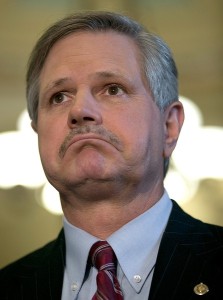North Dakota an example for Obama’s ‘promise zones’

By Rob Port | North Dakota Watchdog
POLICY OVERLAP: President Obama’s new Promise Zones policy is similar to Centers of Excellence policy promoted by former governor and now U.S. Sen, John Hoevenm R-ND.
BISMARCK, N.D. — President Barack Obama’s latest pivot to the economy includes the announcement of public-private Promise Zones aimed at promoting manufacturing in America.
“Each institute is designed to serve as a regional hub designed to bridge the gap between applied research and product development, bringing together companies, universities and other academic and training institutions, and Federal agencies to co-invest in technology areas that encourage investment and production in the U.S.,” a Wednesday news release from the White House states while announcing the first zone in North Carolina. ”
If this sort of public policy sounds familiar to North Dakotans, it should. Obama’s policy bears a remarkable similarity to the Centers of Excellence program U.S. Sen. John Hoeven, R-N.D. put in place while he was governor of the Peace Garden State..
In a 2005 press release from Hoeven’s office announcing the first round of Centers of Excellence funding, the policy was described in much the same way Obama talks about his Promise Zones.
“A Center of Excellence for Economic Development is a hub of research and development on one the campuses of the North Dakota University System around which related businesses expand and dynamic new businesses cluster,” it reads.
If state policy can be used as a predictor for federal policy, the outlook looks to be mixed for Obama’s push.
“As of June 30, 2012, The Centers program has had $635 million in estimated economic impact to North Dakota’s Economy,” states the website for the North Dakota Department of Commerce, charged with oversight of the program. But external reviews paint a different picture with signs of inefficiency, and lack of accountability.
“The majority of the Centers do not measure up to the program’s own standards,” reads a 2008 report from the North Dakota Policy Council, which found that many of the centers weren’t hitting goals for private funding. In a separate report from the same year the NDPC found that the Centers program was costing taxpayers an estimated $42,000 per job created.
According to the program’s most recent annual report from 2012, North Dakota taxpayers have invested nearly $70 million while the program claims to have created 1,082 jobs. That’s a cost of nearly $64,000 per job.
A 2009 state audit ”determined the application process and monitoring of the Centers of Excellence has not provided adequate accountability for the use of state funds. … No determination has been made as to whether the Centers of Excellence are having the desired economic impact as required by state law.”
But some state leaders see the Centers of Excellence as a positive position. While cautioning that the program needs oversight and scrutiny, state Rep. Mark Owens, R-Grand Forks, points to the arrival of the unmanned aerial vehicle industry at the University of North Dakota as an example of the program working.
“I know it’s creating jobs and opportunity,” he said. “It’s not just creating jobs but a new industry.”
Owens said traditionally universities produce research that solves problems, but put that research “in a book and put it on a shelf.” He said the Centers of Excellence program “takes the knowledge off the shelf.”
“From what I’ve seen, it works in North Dakota,” he said.
Hoeven’s office did not return calls for comment.
Contact Rob Port at rport@watchdog.org
The post North Dakota an example for Obama’s ‘promise zones’ appeared first on Watchdog.org.







